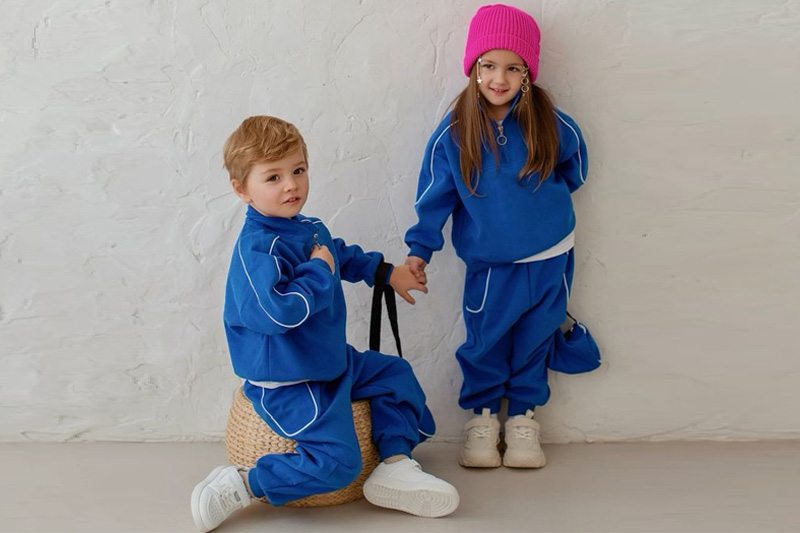Kids aren’t just smaller adults—they're tiny explorers with wild imaginations, endless energy, and zero filter when something’s uncomfortable. That’s why when we design children’s clothing, we can’t just think about how it looks. We’ve got to think about how it moves, stretches, breathes, and fits into the messy, magical world kids live in.
Functional and scene-adapted children’s clothing is about more than fashion—it’s about freedom, safety, comfort, and making parents’ lives easier. From playground to birthday party, the right design supports movement, lasts longer, and earns the trust of families who value both quality and practicality.
Let’s dig into how function-focused design can turn your next kidswear collection from “cute” to “can’t live without it.”
Are our clothes truly made for how kids move, play, and grow?
It’s a fair question. Because kids don’t just wear clothes—they test them.
Designing for children means thinking about movement, durability, and stretch. Clothes should follow a child’s lead—whether they’re crawling under a sofa, doing cartwheels, or falling asleep in the car. Functionality ensures the clothing keeps up with their nonstop energy and rapid growth.
When I worked on a capsule for toddlers, I remember one mom laughing, “If it can survive a playground and spaghetti dinner, I’ll buy 10.” And that stuck with me. Because that’s the test—real life.
Why does outfit versatility matter for modern family lifestyles?
Today’s families are always on the go. One minute it’s preschool, the next it’s grandma’s house, then a dinner out where someone forgot to bring a spare shirt.
Versatile kids’ clothing bridges formal and casual, indoors and outdoors, messy play and picture day. It helps parents do more with less—and cuts down on the need for constant outfit changes.
Let me tell you: the best feedback I ever got was from a dad who said, “My daughter wore that jumpsuit to school, a party, and to sleep—all in one day. It’s magic.” That’s when I realized: versatility isn’t a bonus. It’s the expectation.
How to spot versatile design:
- Simple silhouettes that work with layers
- Neutral tones or playful-but-not-too-loud prints
- Elastic waistbands, easy buttons, minimal fuss
- Materials that clean easily and handle movement
Versatility means value—and parents notice.
Can functional design reduce wardrobe waste and parental frustration?
Absolutely. If something doesn’t fit right, rides up, or shrinks in the wash, it ends up in the “never again” pile.
Clothing with smart, flexible features—like adjustable waistbands, grow-with-me cuffs, and easy-wash fabrics—lasts longer and reduces waste. Parents love items that grow with their kids, not outgrow them in a month.
I remember a mom saying, “If I could buy one outfit and know it’ll last two growth spurts, I’d frame the designer’s photo.” Okay, maybe not literally. But the love is real when function saves money and headaches.
| Common Parent Frustrations | Functional Fixes |
|---|---|
| Too small too fast | Stretchy or adjustable designs |
| Hard to wash | Machine-friendly, colorfast fabrics |
| Uncomfortable for kids | Tag-free seams, breathable materials |
| Easily damaged | Reinforced knees, double stitching |
Clothing that thinks ahead = fewer meltdowns, fewer returns, more smiles.
How does scene-specific clothing improve comfort and safety?
Kids wear different clothes for different settings—and it matters more than we think. A beach outfit isn’t right for a school field trip. Pajamas shouldn’t double as outerwear.
Scene-adapted clothing supports the activity it’s made for—whether it’s breathable fabric for summer camps, flame-resistant sleepwear, or grippy socks for slippery floors. It keeps kids safe, comfortable, and confident.
When we designed fleece-lined joggers for colder climates, we added ankle zippers so kids could get them off without taking off their boots. Small touch. Big difference.
Key examples of scene adaptation:
- Playground wear: Stretch fabric, reinforced knees, elastic cuffs
- School uniforms: Neutral colors, wrinkle-resistant, adjustable fits
- Sleepwear: Soft, tag-free, temperature regulating
- Outdoor wear: Weather-proof, easy-on zippers, reflective details
Designing with the scene in mind shows you care about real-life use—not just how things look on a rack.
Is thoughtful design the key to winning parent trust and loyalty?
Without a doubt. Parents may buy once for the cute print. But they return—and recommend you—for thoughtful details that make life easier.
Thoughtful kidswear design earns parent loyalty by solving small daily problems—easy diaper access, no itchy seams, fast dressing, and long wearability. That attention to detail builds real trust over time.
I once met a mom at a trade show who said, “I’ll switch brands if a single tag scratches my baby’s neck.” That’s how serious it is. Every stitch sends a message: We care about your child.
Trust is built one zipper, one button, one flexible cuff at a time.
Conclusion
When we design kidswear that fits their real lives—how they move, how they grow, where they go—we’re not just making clothes. We’re making life easier for families. And they’ll remember us for it.
Looking for a partner who understands thoughtful kidswear design? Visit Taian Lianchuang Textile Co., Ltd to start a conversation that puts function first.



